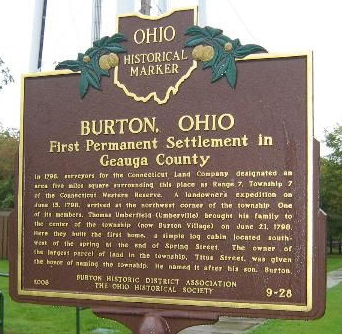 A Brief History of Burton
A Brief History of Burton
Burton is located within the Ohio territory historically knowns as the Connecticut Western Reserve. During the 17th and 18th centuries, western colonial boundaries were ill-defined and extended westward indefinitely. Connecticut's western boundary overlapped New York and Pennsylvania, and the colonial territories argued over land claims and boundaries. After the Revolutionary War, in 1786, Connecticut withdrew its claims to western lands, with the exception of a swath of present-day northeast Ohio. In the late 1790s, the Connecticut Land Company purchased and oversaw the settlement of the eastern two-thirds of the Western Reserve in Ohio, including Geauga County.
As the earliest settlement in the county, Burton is known as a quintessential Western Reserve town. Beginning with the Umberfield family who arrived her in 1798, many early settlers to Burton came from Cheshire, Connecticut. The settlement grew quickly, with two mills operating by 1800, a public school established in 1803, and a collegiate facility, the Burton Academy, completed in 1806. Later development was facilitated by a Baltimore & Ohio railroad station, built in 1874. Although the depot was located two miles away at Burton Station, twice-daily wagon service connected Burton residents to the station. By 1895, the town had grown sufficiently to be incorporated as a Village.
Never dominated by industry, Burton did acquire some small-scale manufacturing interests after the Civil War. Cheese factories and the Burton Handle Company were the most notable. Two cheese factories were operation in 1880, providing an outlet for the area's many dairy farmers. One was located at the natural spring where the Umberfields had first settled.
Burton's post-Civil War "boom" lasted until 1903, when a local bank failure caused decline. The bank's collapse resulted in several long-standing businesses failing, including the Burton Handle Company. Burton's economic recovery was due, in part, to the Belle-Vernon Creamery, which replaced its old factory on Spring Street with a new larger facility in 1905. Throughout the remainder of the 20th century, Burton has realized economic and residential stability. Since 1890, Burton's population has not deviated dramatically from 1200 inhabitants.